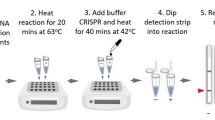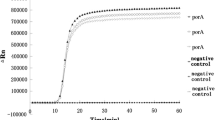Abstract
The Roche Cobas Amplicor system is widely used for the detection of Neisseria gonorrhoeae but is known to cross react with some commensal Neisseria spp. Therefore, a confirmatory test is required. The most common target for confirmatory tests is the cppB gene of N. gonorrhoeae. However, the cppB gene is also present in other Neisseria spp. and is absent in some N. gonorrhoeae isolates. As a result, laboratories targeting this gene run the risk of obtaining both false-positive and false-negative results. In the study presented here, a newly developed N. gonorrhoeae LightCycler assay (NGpapLC) targeting the N. gonorrhoeae porA pseudogene was tested. The NGpapLC assay was used to test 282 clinical samples, and the results were compared to those obtained using a testing algorithm combining the Cobas Amplicor System (Roche Diagnostics, Sydney, Australia) and an in-house LightCycler assay targeting the cppB gene (cppB-LC). In addition, the specificity of the NGpapLC assay was investigated by testing a broad panel of bacteria including isolates of several Neisseria spp. The NGpapLC assay proved to have comparable clinical sensitivity to the cppB-LC assay. In addition, testing of the bacterial panel showed the NGpapLC assay to be highly specific for N. gonorrhoeae DNA. The results of this study show the NGpapLC assay is a suitable alternative to the cppB-LC assay for confirmation of N. gonorrhoeae-positive results obtained with Cobas Amplicor.

Similar content being viewed by others
References
Palmer HM, Mallinson H, Wood RL, Herring AJ (2003) Evaluation of the specificities of five DNA amplification methods for the detection of Neisseria gonorrhoeae. J Clin Microbiol 41:835–837
Farrell DJ (1999) Evaluation of AMPLICOR Neisseria gonorrhoeae PCR using cppB nested PCR and 16S rRNA PCR. J Clin Microbiol 37:386–390
Ho BS, Feng WG, Wong BK, Egglestone SI (1992) Polymerase chain reaction for the detection of Neisseria gonorrhoeae in clinical samples. J Clin Pathol 45:439–442
Whiley DM, LeCornec GM, Mackay IM, Siebert DJ, Sloots TP (2002) A real-time PCR assay for the detection of Neisseria gonorrhoeae by LightCycler. Diagn Microbiol Infect Dis 42:85–89
Tabrizi SN, Chen S, Cohenford MA, Lentrichia BB, Coffman E, Shultz T, Tapsall JW, Garland SM (2004) Evaluation of real time polymerase chain reaction assays for confirmation of Neisseria gonorrhoeae in clinical samples tested positive in the Roche Cobas Amplicor assay. Sex Transm Infect 80:68–71
Tapsall J, Limnios A, Carter I, Lum G, Freeman K, Sloots T (2003) A cluster of culture-positive, but PCR false negative infections with Neisseria gonorrhoeae. Program and abstracts, 15th Biennial Congress of the International Society for Sexually Transmitted Diseases Research (ISSTDR). Abstract no. 0129
Feavers IM, Maiden MC (1998) A gonococcal porA pseudogene: implications for understanding the evolution and pathogenicity of Neisseria gonorrhoeae. Mol Microbiol 30:647–656
Perrin A, Nassif X, Tinsley C (1999) Identification of regions of the chromosome of Neisseria meningitidis and Neisseria gonorrhoeae which are specific to the pathogenic Neisseria species. Infect Immun 67:6119–6129
Leslie DE, Azzato F, Ryan N, Fyfe J (2003) An assessment of the Roche Amplicor Chlamydia trachomatis/Neisseria gonorrhoeae multiplex PCR assay in routine diagnostic use on a variety of specimen types. Commun Dis Intell 27:373–379
van der Ende A, Hopman CT, Dankert J (1999) Deletion of porA by recombination between clusters of repetitive extragenic palindromic sequences in Neisseria meningitidis. Infect Immun 67:2928–2934
Newcombe J, Cartwright K, Dyer S, McFadden J (1998) Naturally occurring insertional inactivation of the porA gene of Neisseria meningitidis by integration of IS1301. Mol Microbiol 30:453–454
Jelfs J, Munro R, Wedege E, Caugant DA (2000) Sequence variation in the porA gene of a clone of Neisseria meningitidis during epidemic spread. Clin Diagn Lab Immunol 7:390–395
Acknowledgments
This study was supported by the Royal Children’s Hospital Foundation Grant No. 922-034, which is sponsored by the Woolworths Fresh Futures Campaign. We thank G. Lum and K. Freeman (Pathology Department, Royal Darwin Hospital, Northern Territory), P. Hallsworth (Microbiology Department Flinders Medical Centre, South Australia) and F. Francis (Queensland Health Pathology Service, Townsville General Hospital) for supplying bacterial isolates.
We thank the staff of the Molecular Diagnostic Unit, Microbiology Division, Queensland Health Pathology Service, Royal Brisbane Hospital campus, for supplying the clinical specimens and performing the Roche Cobas Amplicor assay.
This is Sir Albert Sakzewski Virus Research Centre manuscript number 214.
Author information
Authors and Affiliations
Corresponding author
Rights and permissions
About this article
Cite this article
Whiley, D.M., Buda, P.J., Bayliss, J. et al. A new confirmatory Neisseria gonorrhoeae real-time PCR assay targeting the porA pseudogene. Eur J Clin Microbiol Infect Dis 23, 705–710 (2004). https://doi.org/10.1007/s10096-004-1170-0
Published:
Issue Date:
DOI: https://doi.org/10.1007/s10096-004-1170-0




